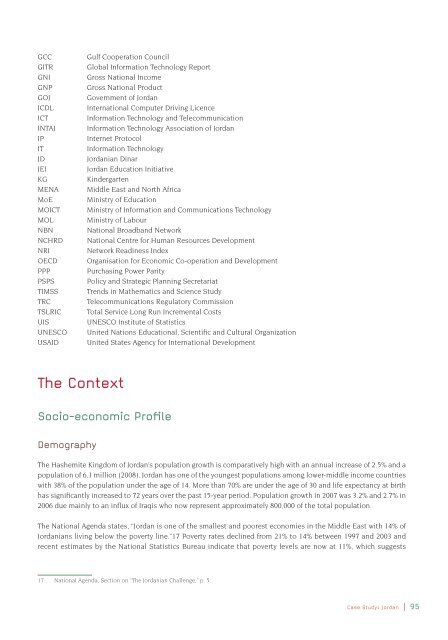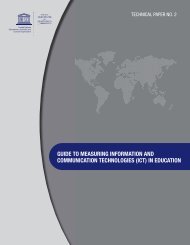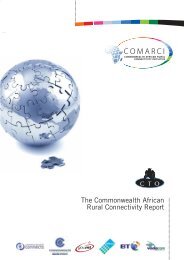Transforming education: the power of ICT policies - Commonwealth ...
Transforming education: the power of ICT policies - Commonwealth ...
Transforming education: the power of ICT policies - Commonwealth ...
You also want an ePaper? Increase the reach of your titles
YUMPU automatically turns print PDFs into web optimized ePapers that Google loves.
GCC Gulf Cooperation Council<br />
GITR Global Information Technology Report<br />
GNI Gross National Income<br />
GNP Gross National Product<br />
GOJ Government <strong>of</strong> Jordan<br />
ICDL International Computer Driving Licence<br />
<strong>ICT</strong> Information Technology and Telecommunication<br />
INTAJ Information Technology Association <strong>of</strong> Jordan<br />
IP Internet Protocol<br />
IT Information Technology<br />
JD Jordanian Dinar<br />
JEI Jordan Education Initiative<br />
KG Kindergarten<br />
MENA Middle East and North Africa<br />
MoE Ministry <strong>of</strong> Education<br />
MO<strong>ICT</strong> Ministry <strong>of</strong> Information and Communications Technology<br />
MOL Ministry <strong>of</strong> Labour<br />
NBN National Broadband Network<br />
NCHRD National Centre for Human Resources Development<br />
NRI Network Readiness Index<br />
OECD Organisation for Economic Co-operation and Development<br />
PPP Purchasing Power Parity<br />
PSPS Policy and Strategic Planning Secretariat<br />
TIMSS Trends in Ma<strong>the</strong>matics and Science Study<br />
TRC Telecommunications Regulatory Commission<br />
TSLRIC Total Service Long Run Incremental Costs<br />
UIS UNESCO Institute <strong>of</strong> Statistics<br />
UNESCO United Nations Educational, Scientifi c and Cultural Organization<br />
USAID United States Agency for International Development<br />
The Context<br />
Socio-economic Pr<strong>of</strong>i le<br />
Demography<br />
The Hashemite Kingdom <strong>of</strong> Jordan’s population growth is comparatively high with an annual increase <strong>of</strong> 2.5% and a<br />
population <strong>of</strong> 6.1 million (2008). Jordan has one <strong>of</strong> <strong>the</strong> youngest populations among lower-middle income countries<br />
with 38% <strong>of</strong> <strong>the</strong> population under <strong>the</strong> age <strong>of</strong> 14. More than 70% are under <strong>the</strong> age <strong>of</strong> 30 and life expectancy at birth<br />
has signifi cantly increased to 72 years over <strong>the</strong> past 15-year period. Population growth in 2007 was 3.2% and 2.7% in<br />
2006 due mainly to an infl ux <strong>of</strong> Iraqis who now represent approximately 800,000 <strong>of</strong> <strong>the</strong> total population.<br />
The National Agenda states, “Jordan is one <strong>of</strong> <strong>the</strong> smallest and poorest economies in <strong>the</strong> Middle East with 14% <strong>of</strong><br />
Jordanians living below <strong>the</strong> poverty line.”17 Poverty rates declined from 21% to 14% between 1997 and 2003 and<br />
recent estimates by <strong>the</strong> National Statistics Bureau indicate that poverty levels are now at 11%, which suggests<br />
17 National Agenda, Section on “The Jordanian Challenge,” p. 5.<br />
Case Study: Jordan | 95
















